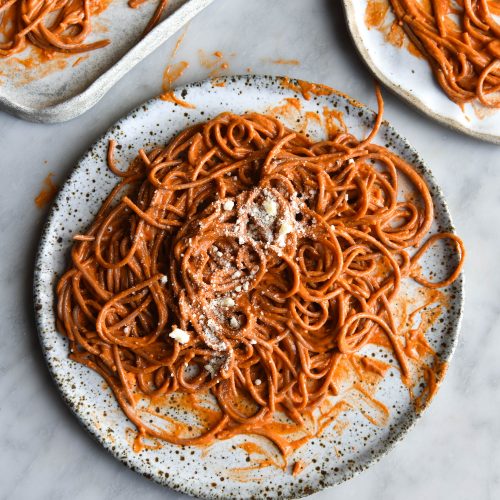
FODMAP friendly pasta alla vodka
Vegetarian, gluten free, FODMAP friendly, nut free*This recipe uses Australian cups and measures. Use gram and ml for international accuracy,
Ingredients
- 250 g gluten free pasta
- 50 g butter dark browned
- 125g tomato paste
- 20ml (1 tablespoon)* lemon juice
- lemon zest to your taste (I use 1/2 a lemon)
- 1 teaspoon light brown sugar
- 1 teaspoon balsamic vinegar
- 1/4 - 1/2 teaspoon chilli flakes
- freshly cracked pepper to taste
- 60ml (1/4 cup)* vodka
- 1/4 - 1/2 teaspoon asafoetida also called hing powder (see notes)
- 125ml (1/4 cup)* lactose free cream
- 125ml (1/4 cup)* starchy pasta water or as much as necessary to create a smooth and glossy sauce
- 75 g finely and freshly grated parmesan see notes
- Fine salt to taste
Instructions
- Heat a large wok/pot half filled with well salted water over a high heat. I like to use a wok for spaghetti because it fits in the liquid without me having to stand there and push it down while it softens, but you can use a pot if you prefer. Whatever you do, keep the water to a minimum (just enough to cover and cook the pasta) – this will make the pasta water extra starchy, so it has extra ability to emulsify the sauce.
- Once the water is boiling, add your pasta and stir to make sure it separates. Stir it intermittently while you work on the sauce.
- In a large skillet or pan, heat the butter over a medium heat. Continue, stirring intermittently, until it becomes a deep brown. It should smell nutty and delicious.
- Add the tomato paste and use a silicon spatula to push it around and cook it in the brown butter. It will probably sizzle up considerably before settling down. Cook for 2-3 minutes or until some of the butter has been absorbed by the tomato paste.
- Add the lemon juice and zest, light brown sugar, balsamic, chilli flakes and freshly cracked pepper. Stir to combine.
- Add the vodka to deglaze the pan and stir to pick up all the little browned bits on the bottom. Add the asafoetida while the sauce is liquidy to disperse it evenly, if you’re using it.
- At any time if the sauce is sticking, add 60ml (1/4 cup) of what should now be starchy pasta water.
- Take the sauce off the heat and add the cream a bit at a time, stirring to combine between each addition.
- The pasta should hopefully be al dente, so take it off the heat. I prefer to use tongs to drop it into the sauce, so that some extra pasta water piggybacks into it. Use your spatula to incorporate the sauce and pasta until it is completely coated.
- Add the parmesan bit by bit and work quickly to agitate the pasta and incorporate the parmesan into the sauce. Add 60ml (1/4 cup) starchy pasta water as necessary to create a smooth and glossy sauce. Season it to your taste.
- Sprinkle with a little extra parmesan or basil and serve immediately.
Tried this recipe?Let us know how it was!